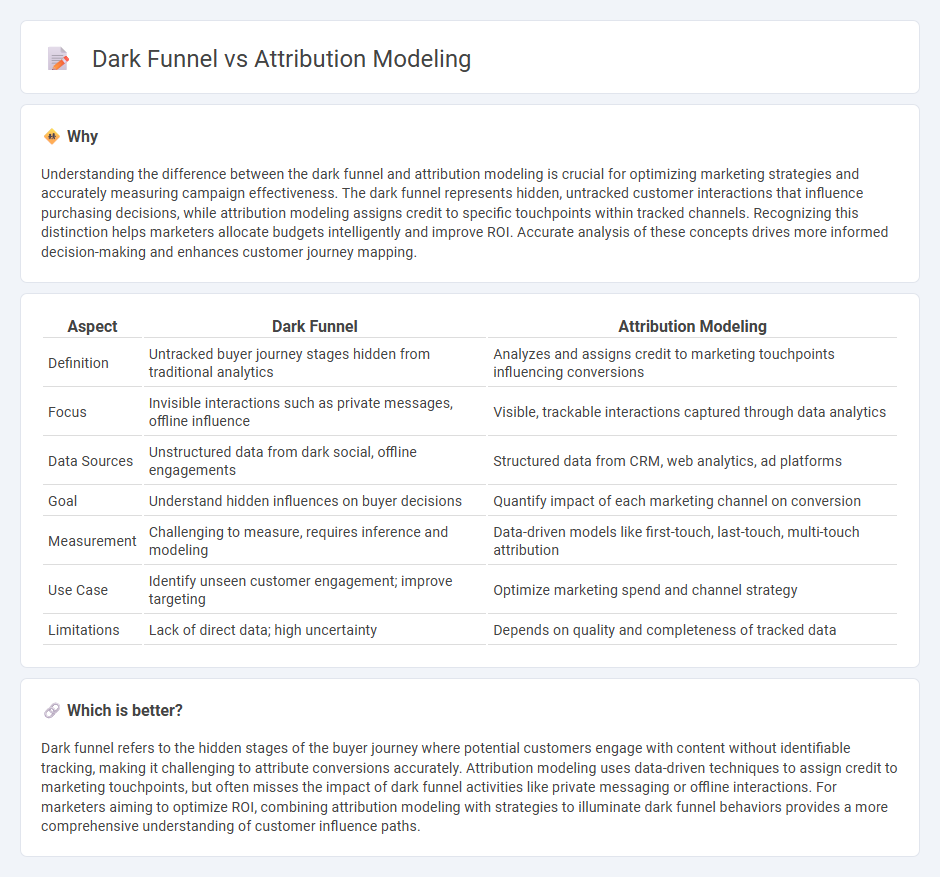
Dark funnel marketing captures customer interactions that remain hidden from traditional analytics, encompassing touchpoints like anonymous browsing and offline engagements. Attribution modeling attempts to assign credit to various marketing channels based on tracked user data but often misses these invisible influences, leading to incomplete insights. Explore how understanding both dark funnel dynamics and attribution modeling can enhance marketing strategies.
Why it is important
Understanding the difference between the dark funnel and attribution modeling is crucial for optimizing marketing strategies and accurately measuring campaign effectiveness. The dark funnel represents hidden, untracked customer interactions that influence purchasing decisions, while attribution modeling assigns credit to specific touchpoints within tracked channels. Recognizing this distinction helps marketers allocate budgets intelligently and improve ROI. Accurate analysis of these concepts drives more informed decision-making and enhances customer journey mapping.
Comparison Table
| Aspect | Dark Funnel | Attribution Modeling |
|---|---|---|
| Definition | Untracked buyer journey stages hidden from traditional analytics | Analyzes and assigns credit to marketing touchpoints influencing conversions |
| Focus | Invisible interactions such as private messages, offline influence | Visible, trackable interactions captured through data analytics |
| Data Sources | Unstructured data from dark social, offline engagements | Structured data from CRM, web analytics, ad platforms |
| Goal | Understand hidden influences on buyer decisions | Quantify impact of each marketing channel on conversion |
| Measurement | Challenging to measure, requires inference and modeling | Data-driven models like first-touch, last-touch, multi-touch attribution |
| Use Case | Identify unseen customer engagement; improve targeting | Optimize marketing spend and channel strategy |
| Limitations | Lack of direct data; high uncertainty | Depends on quality and completeness of tracked data |
Which is better?
Dark funnel refers to the hidden stages of the buyer journey where potential customers engage with content without identifiable tracking, making it challenging to attribute conversions accurately. Attribution modeling uses data-driven techniques to assign credit to marketing touchpoints, but often misses the impact of dark funnel activities like private messaging or offline interactions. For marketers aiming to optimize ROI, combining attribution modeling with strategies to illuminate dark funnel behaviors provides a more comprehensive understanding of customer influence paths.
Connection
Dark funnel refers to the untracked customer touchpoints during the buying journey that traditional analytics fail to capture, making marketing attribution modeling incomplete. Attribution modeling aims to assign value to various marketing channels and interactions but struggles with gaps caused by dark funnel activities such as offline influence, private messaging, and anonymous content consumption. Integrating advanced data collection methods and multi-touch attribution models helps illuminate the dark funnel, enhancing the accuracy of marketing ROI measurement.
Key Terms
**Attribution Modeling:**
Attribution modeling systematically evaluates the impact of various marketing touchpoints to determine which channels contribute most effectively to conversions, using data-driven algorithms such as first-click, last-click, and multi-touch models. It contrasts with the dark funnel, where hidden or untraceable interactions influence the buyer's journey outside traditional tracking methods. Explore more about how attribution modeling enhances marketing ROI and decision-making effectiveness.
Conversion Path
Attribution modeling analyzes specific touchpoints in the conversion path to assign credit to marketing channels, providing measurable insights into how each interaction influences customer actions. The dark funnel represents untracked or anonymous interactions, such as offline engagements and untraceable social media impressions, that contribute to conversion but remain outside traditional attribution frameworks. Explore more to understand how blending these concepts can optimize marketing strategies and uncover hidden revenue drivers.
Multi-Touch Attribution
Multi-Touch Attribution (MTA) provides detailed insights into customer journeys by assigning credit to multiple marketing touchpoints, boosting campaign optimization accuracy compared to traditional attribution models. The dark funnel refers to unseen, informal interactions like peer recommendations and organic research that MTA often struggles to capture, leading to gaps in understanding true conversion drivers. Explore advanced multi-touch attribution strategies to illuminate hidden channels and maximize marketing ROI effectively.
Source and External Links
A Beginner's Guide to Attribution Model Frameworks - Attribution modeling is a framework to assign credit for conversions to different marketing touchpoints, helping businesses understand which channels and efforts are most effective, with main types including single-touch and multi-touch models such as linear, rule-based, and algorithmic attribution.
What is Attribution Modeling? Why It Matters & ... - Multi-touch attribution models distribute credit among multiple touchpoints, examples include linear (equal credit), time decay (more recent touchpoints get more credit), U-shaped (first and last get 40% each), W-shaped, and Z-shaped models assigning credit based on position and milestones in the customer journey.
Marketing attribution -- models and best practices - Marketing attribution determines which interactions influence purchases, with multi-touch models like linear, position-based, W-shaped, and time decay assigning credit across multiple touchpoints to better understand marketing impact.
 dowidth.com
dowidth.com